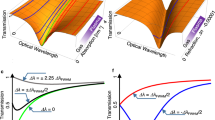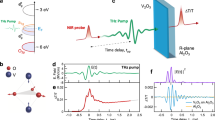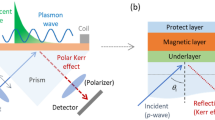Abstract
Maximum modulation of light transmission occurs when an opaque medium is suddenly made transparent. This phenomenon occurs in atomic and molecular gases through different mechanisms1,2, whereas much room remains for further studies in solids3,4,5. A plasma is an illustrative system showing opacity for low-frequency light, and light–plasma interaction theory provides a universal framework to describe diverse phenomena including radiation in space plasmas6, diagnostics of laboratory plasmas7 and collective excitations in condensed matter8. However, induced transparency in plasmas remains relatively unexplored9. Here, we use coherent terahertz magneto-spectroscopy to reveal a thermally and magnetically induced transparency in a semiconductor plasma. A sudden appearance and disappearance of transmission through electron-doped InSb is observed over narrow temperature and magnetic field ranges, owing to coherent interference between left- and right-circularly polarized terahertz eigenmodes. Excellent agreement with theory reveals long-lived coherence of magneto-plasmons and demonstrates the importance of coherent interference in the terahertz regime.
This is a preview of subscription content, access via your institution
Access options
Subscribe to this journal
Receive 12 print issues and online access
$259.00 per year
only $21.58 per issue
Buy this article
- Purchase on SpringerLink
- Instant access to full article PDF
Prices may be subject to local taxes which are calculated during checkout




Similar content being viewed by others
References
Harris, S. E. Electromagnetically induced transparency. Phys. Today 50, 36–42 (1997).
McCall, S. L. & Hahn, E. L. Self-induced transparency by pulsed coherent light. Phys. Rev. Lett. 18, 908–911 (1967).
Zhao, Y., Wu, C., Ham, B., Kim, M. K. & Award, E. Microwave induced transparency in ruby. Phys. Rev. Lett. 79, 641–644 (1997).
Phillips, M. et al. Electromagnetically induced transparency in semiconductors via biexciton coherence. Phys. Rev. Lett. 91, 183602 (2003).
Srivastava, A., Srivastava, R., Wang, J. & Kono, J. Laser-induced above-band-gap transparency in GaAs. Phys. Rev. Lett. 93, 157401 (2004).
Zheleznyakov, V. V. Radiation in Astrophysical Plasmas (Kluwer Academic, 1996).
Hutchinson, I. H. Principles of Plasma Diagnostics (Cambridge Univ. Press, 1987).
Platzman, P. M. & Wolf, P. A. Waves and Interactions in Solid State Plasmas, Solid State Physics Supplement 13 (Academic, 1973).
Litvak, A. G. & Tokman, M. D. Electromagnetically induced transparency in ensembles of classical oscillators. Phys. Rev. Lett 88, 095003 (2002).
Palik, E. D. & Furdyna, J. K. Infrared and microwave magnetoplasma effects in semiconductors. Rep. Prog. Phys. 33, 1193–1322 (1970).
McCombe, B. D. & Wagner, R. J. in Advances in Electronics and Electron Physics Vol. 37 (ed. Marton, L.) 1–79 (Academic, 1975).
Chamberlain, J. M. & Miles, R. E. (eds) in New Directions in Terahertz Technology (Kluwer Academic, 1997).
Tonouchi, M. Cutting-edge terahertz technology. Nature Photon. 1, 97–105 (2007).
Chen, H.-T. et al. Active terahertz metamaterial devices. Nature 444, 597–600 (2006).
Wang, X. et al. Terahertz time-domain magnetospectroscopy of a high-mobility two-dimensional electron gas. Opt. Lett. 32, 1845–1847 (2007).
Akhiezer, A. I. Plasma Electrodynamics (Elsevier, 1975).
Lifshitz, E. M. & Pitaevskii, L. P. Physical Kinetics, Course of Theoretical Physics Vol. 10 (Pergamon, 1981).
Adachi, S. GaAs and Related Materials (World Scientific, 1994).
Avizour, Y. & Shvets, G. Manipulating electromagnetic waves in magnetized plasmas: Compression, frequency shifting, and release. Phys. Rev. Lett. 100, 065006 (2008).
Acknowledgements
This work was supported by the National Science Foundation through Award Nos. DMR-0134058, DMR-0325474, ECS-0547019 (CAREER) and OISE-0530220 and the Robert A. Welch Foundation through Grant No. C-1509. We thank A. Srivastava for technical assistance.
Author information
Authors and Affiliations
Contributions
X.W., S.A.C., D.M.M. and J.K. carried out the terahertz measurements. A.A.B. developed the theoretical model and carried out theoretical simulations. All authors analysed the experimental data and contributed to the preparation of the manuscript.
Corresponding author
Supplementary information
Supplementary Information
Supplementary Information (PDF 313 kb)
Rights and permissions
About this article
Cite this article
Wang, X., Belyanin, A., Crooker, S. et al. Interference-induced terahertz transparency in a semiconductor magneto-plasma. Nature Phys 6, 126–130 (2010). https://doi.org/10.1038/nphys1480
Received:
Accepted:
Published:
Issue date:
DOI: https://doi.org/10.1038/nphys1480
This article is cited by
-
Ultrasmall and tunable TeraHertz surface plasmon cavities at the ultimate plasmonic limit
Nature Communications (2023)
-
Thermally tunable Dyakonov surface waves in semiconductor nanowire metamaterials
Scientific Reports (2023)
-
On-chip terahertz isolator with ultrahigh isolation ratios
Nature Communications (2021)
-
Plasmonic semiconductor nanogroove array enhanced broad spectral band millimetre and terahertz wave detection
Light: Science & Applications (2021)
-
A tunable circular-polarization-sensitive absorber based on InSb
Applied Physics B (2021)



